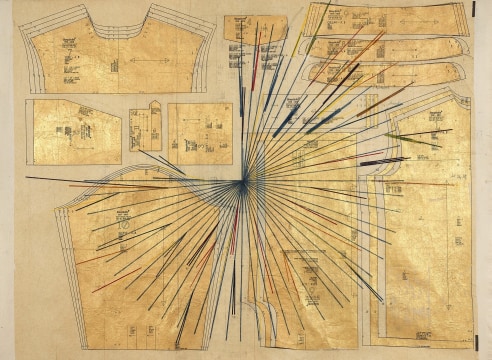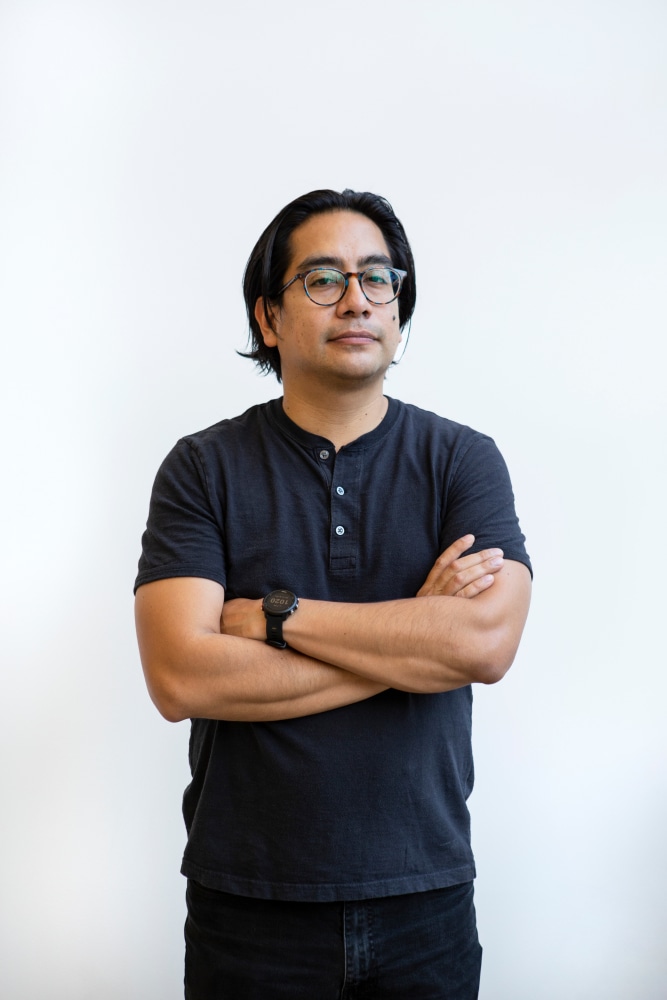

Ronny Quevedo, 2021. Photo: Ross Collab
Alexander Gray Associates announces representation of Ronny Quevedo (b.1981). Quevedo’s practice spans installation, drawings, and prints, incorporating and subverting aspects of abstraction, painting, collage, cartography, and sports imagery. Deeply engaged with notions of identity and the intersection of mainstream and historically marginalized cultures, Quevedo reenvisions pre- and post-colonial iconographies, offering nuanced examinations of personal and social histories. This recuperation of indigenous languages of abstraction, the revalorization of their associated labor, and the centering of a living connection between contemporary and centuries-old cultural markers remain key to Quevedo’s ongoing practice. Alexander Gray Associates will present Quevedo’s first one-person exhibition with the Gallery in fall 2022.
“Ronny Quevedo has developed a distinct, conceptually rigorous visual vocabulary as he explores shifting frameworks of identity, history, and culture,” said Alexander Gray, Co-Owner and Principal of Alexander Gray Associates. “His artworks excite the eye with detail and layer, locate the body with environment and scale, and connect cultural traditions with contemporary socio-political mapping and movement. With research and exacting craft, Ronny’s practice expands questions about lineage and location—artistic, personal, and political. We are delighted to welcome him to the Gallery.”
From the materials he uses to the themes he explores, Ronny Quevedo’s work is rooted in an exploration of his own history and identity, initially using his art as a way to understand the lives and experiences of his parents. Quevedo’s father was a professional soccer player in Ecuador and the artist often incorporates the reconstructed and reorganized lines of athletic fields in his work. Similarly, the influence of Quevedo’s mother’s work as a dressmaker is evidenced in his incorporation of mediums like muslin and wax tracing paper. “To me,” says Quevedo, “there is no division of significance; these humble technical materials can be imaginatively and resourcefully transformed. My family history, which contained lots of adaptation, embodies this capacity for transformation.” By contextualizing these materials with ostensibly precious materials like gold and silver leaf, Quevedo invites the viewer to interrogate the simultaneous valuation of certain luxuries and erasure of the artisans who create them.
Beyond contributing to the formal, material, and conceptual elements of his practice, Quevedo’s family histories serve as prompts to consider the political and social implications of how bodies, or groups of bodies, exist and operate in space. “My visual language incorporates topographies that echo the strategies of pathfinding utilized by migrants. The movement of bodies, like those of constellations, posit geography and space as liminal positions, like players in space.” Through his employment of lines, grids, and diagrammatic visuals, Quevedo’s works take on a cartographic quality that not only explores the complex intersections between the personal and the cultural, but offers the possibility of reimagining and reconfiguring geographic and historical positions.
Central to Quevedo’s practice is the incorporation of and reverence for the cultural heritage of the Americas. For Quevedo, pre-Columbian history “is associated with having been conquered and, thus, a sense that its culture exists in a past that is extinct. . . . When I reference Inca or Wari culture in my work, I’m looking into a cultural space and approach whose legacy continues to be influential. This is a conscious decision to resist contemporary notions of minimalism and abstraction as apolitical and asymbolic. Indigenous South American cultures developed their own visual language of abstraction, one that points to a lineage of thought that exists outside of the figurative and the textual, in ways not traditionally acknowledged in the Western art-historical canon.”
Expanding on the histories and possibilities of textiles and papermaking, recent works such as myself when i am real - sin ti soy nadie (2021) are imbued with an added dimension: a sculptural approach that emphasizes the presence of the physical body. The result of a meticulous process that involves cutting slivers of pattern paper, reassembling them into abstract compositions, and fusing their surface together with gold leaf on muslin, myself when i am real. . . is designed to be doubled over and hung in the exhibition space, so that viewers can interact with both its aesthetically refined surface and its three-dimensional presence. The incorporation of muslin and the positioning as a draped object emphasize the work’s material and conceptual connection to the living legacy of South American textiles, indicating the artist’s increasingly complex and sophisticated elaboration on his core themes.
Ronny Quevedo’s one-person exhibition Ronny Quevedo: offside at the University Art Museum, University of Albany, NY, is on view January 25–April 2, 2022, and Quevedo’s work has been the subject of previous one-person exhibitions, including Ronny Quevedo: at the line, Colorado Springs Fine Arts Center, Colorado College, CO (2021); no hay medio tiempo / there is no halftime, Temple Contemporary, Tyler School of Art and Architecture, Philadelphia, PA (2019); Space of Play, Play of Space, Martin Art Gallery, Muhlenberg College, Allentown, PA (2019); no hay medio tiempo / there is no halftime, Queens Museum, NY (2017); and Home Field Advantage, Casita Maria Center for Arts & Education, Bronx, NY (2015). Quevedo has also been included in a number of group exhibitions, including ReVisión, Denver Art Museum, CO (2021); Comunidades Visibles: The Materiality of Migration, Albright-Knox Art Gallery, Buffalo, NY (2021); Ace: Art on Sports, Promise, and Selfhood, University Art Museum, University of Albany, NY (2019); Pacha, Llacta, Wasichay; Indigenous Space, Modern Architecture, New Art, Whitney Museum of American Art, New York, NY (2018); The World’s Game: Fútbol and Contemporary Art, Perez Art Museum, Miami, FL (2018); Monarchs Brown and Native Contemporary Artists in the Path of the Butterfly, Blue Star Contemporary, San Antonio, TX (2018), traveled to Museum of Contemporary Art North Miami, FL (2018); Monarchs: Brown and Native Contemporary Artists in the Path of the Butterfly, Bemis Center for Contemporary Art, Omaha, NE (2017); The Socrates Annual, Socrates Sculpture Park, Queens, NY (2017); Open Sessions: Drawings in Context / Field, Queens Museum, NY (2015); Moving, Not Moving, The McKinney Avenue Contemporary, Dallas, TX (2014); 2014 Core Exhibition, Museum of Fine Arts, Houston, TX (2014); Reading Lists: Artists’ Selections from the MOMA Library Collection, Museum of Modern Art, New York, NY (2013); 2013 Core Exhibition, Museum of Fine Arts, Houston, TX (2013); Eyes Off the Flag, Motus Fort, Tokyo, Japan (2012); El Museo’s Bienal: The (S) Files 2011, El Museo del Barrio, New York, NY (2011); and How Soon is Now?, Bronx Museum of the Arts, NY (2008).
Quevedo’s work is in the collections of the Albright-Knox Art Gallery, Buffalo, NY; the Colorado Springs Fine Arts Center at Colorado College, CO; the Denver Art Museum, CO; the Museum of Old and New Art, Hobart, Tasmania, Australia; and the Whitney Museum of American Art, New York, NY. He is the recipient of many awards and grants, including the Joan Mitchell Fellowship, the Joan Mitchell Foundation (2021); the Harpo Foundation New Work Project Grant (2021); the Jerome Hill Artists Fellowship, Jerome Foundation (2019); the A Blade of Grass Fellowship for Socially Engaged Art (2017); the Socrates Sculpture Park Artist Fellowship (2017); the Queens Museum/Jerome Foundation Fellowship for Emerging Artists (2016); the Eliza Long Prize from the Museum of Fine Arts, Houston (2013–2014); the New American Paintings MFA Annual 99 (2012); the BRIO Award, the Bronx Council on the Arts (2011); the Gloucester Landscape Painting Prize, Yale School of Art (2011); and the PRINT Magazine Regional Design Annual (2008). He currently lives and works in The Bronx, NY.